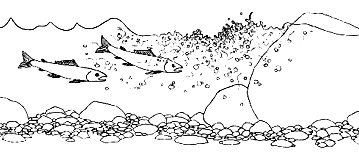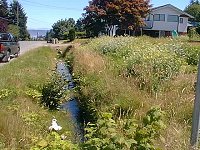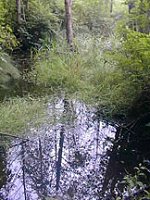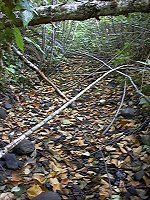WATER
WHY IS WATER IMPORTANT?
Water is a salmon's home.
It has oxygen to breath and food to eat.
Salmon live in both fresh water and salt water.

Water is the most obvious and also the most important part of a stream. Although fish are always under they are able to extract air from the water using their gills. The water is also home to many insects and larvae which salmon eat to survive.
Salmon live in fresh water such as creeks and rivers when they are first born. They will swim down stream to live in the saltwater of the open ocean for much of their life once they reach their smolting age. After their ocean voyage and adulthood has been reached, they will return to their fresh water streams of origin to spawn and lay eggs, completing their life cycle.
WHAT WATER IS IMPORTANT?
All water is important to fish. Water in ditches, culverts and swamps is just as important as water in streams.

It is not only natural-looking creeks and streams that are important water sources to fish. The drainage ditch on the side of the road may also be supporting salmon. These ditches, along with water that is carried in city storm drains and culverts can be very important sources of water  for salmon streams. This unseen water may even be fish habitat themselves. Many cities have painted fish beside these storm drain to remind you that the water that runs off the street does in fact directly influence fish habitat.
for salmon streams. This unseen water may even be fish habitat themselves. Many cities have painted fish beside these storm drain to remind you that the water that runs off the street does in fact directly influence fish habitat.
WATER QUALITY
There are many different factors in the stream which are important to salmon.
OXYGEN
There must be enough oxygen in the water for fish to breathe.
The most important component of water quality is the amount of dissolved oxygen in the water. This is a measure of how much oxygen is mixed in with the water available for salmon to breathe. As water flows downstream, it is rolled around and mixed by rocks, waterfalls, and anything else that stops it from flowing in a straight line. As this mixing occurs oxygen from above the surface is blended into the water. The amount of oxygen that is dissolved in the water is what is available to fish. A salmon requires at least 6 parts per million (ppm) of dissolved oxygen to breathe comfortably.
CLEAN WATER
Water must be clean for fish to live.
Too much silt and pollution in a stream makes it hard for salmon to see and breathe.
A salmon also needs very clean water to live. If there is too much debris mixed in the water, it becomes very difficult for the fish to see and breathe. When this happens, the water is said to be turbid. You can measure how turbid a stream is by placing a ruler into the water until the end can no longer be seen. The number at the surface indicates how much water you can see through.
TEMPERATURE
Salmon also need cool water to be comfortable.
The temperature of the water is another very important factor in fish survival. Water temperatures higher than 25ÉC are lethal to some species of fish such as coho salmon. Temperatures below 0ÉC threaten freezing young fish. Optimum temperatures for most salmon are in the range of 3ÉC to 15ÉC. This temperature range will allow salmon to be at their peak metabolic rate and therefore swim, eat, and grow at their fastest.
Water temperatures also influence incubation rates and the time that eggs will hatch. Generally warmer waters will speed up the growth rates of salmon eggs, alevin, and fry.
ACIDITY
The pH of the water must be close to neutral for salmon to be comfortable.
"pH" indicates how acidic or basic water is. Ideal pH for salmon is 7 or slightly lower. 7 is exactly the middle of the pH scale and indicates neutral water. Salmon can tolerate some gradual variation in the pH of their water, although salmon may die if the water becomes too acidic or basic.
OTHER CONDITIONS
Salmon are very sensitive to all types of pollution.
Other factors such as Total Dissolved Solids (TDS), Nitrates, Conductivity and the concentration of a wide range of pollutants must also be considered when determining water quality.
WATER FLOWS
Salmon will live in streams of all sizes, as long as there is enough habitat.
Fish live in all sorts of streams. Some are hundreds of meters wide, while some are no wider than 1 meter. Different species of salmon will have specific preferences to the size of their stream. For example, coho will spend much of their time in small streams and even smaller tributaries, whereas chinook are much less picky about the size of their spawning stream.
Pools are valuable fish habitat

As young fry, salmon spend much of their time in quiet deep pools in various types of streams. Here they can feed on the many insects and larvae that surround them. Slow moving pools also allow salmon to seek shelter from predators.
Fast water provides streams with valuable oxygen when it gets mixed with the air.

Faster moving water such as "cascades" and "riffles," provide an important source of oxygen into the water. As the water flows between and over rocks air gets mixed into the water, raising the amount of oxygen usable to fish.
Fish of all ages generally don't have any problem swimming up fast moving water, unless it is too fast, such as a hydro-dam or waterfalls. Larger salmon that have returned to their river to spawn and lay eggs are very determined and may be able to jump and swim up waterfalls 3 or 4 meters high.
FLOODING
When streams flood, salmon often seek shelter away from the fast waters.
During much of the winter, heavy rains in British Columbia cause frequent flooding in many streams and rivers. Flooding can also be attributed to melting snow in the mountains, or a damaged natural system that can no longer handle varying amounts of water. Sometimes flooding is quite beneficial for salmon, however floods can destroy salmon habitat. If frequent or powerful flooding occurs, many eggs that have already been laid can be washed down stream along with the gravel. On the other hand, coho salmon will actually wait for their little streams to flood so that they can get across the beach and back into them to spawn.
THE DRY SEASON
When salmon streams dry up, their home is taken away. Coho and other salmon must find water somewhere or they will die.

Potentially more dangerous to the health of fish are the long hot dry months of summer. During this season much of the water in the smaller streams and creeks dries up and is not replenished. When there is too little water, the fish often get trapped in very small shallow pools with very little oxygen and temperatures that are too warm to live in. In addition to causing stress in the young fish, low water levels will also make them very visible and give predators such as birds and other land-based animals an easy opportunity for a snack.
STREAM GRADIENT
Salmon cannot swim up streams that are too steep.
Stream gradient is an important factor in the creation of fish habitat. For example, mountainous areas with long steep streams often consist of rough shallow riffle-type waters, giving salmon fewer opportunities to rest and gather energy in calm pools.
The velocity and discharge of water in a stream are also dependent on its gradient. The steeper the terrain, generally the faster water will flow. A high water velocity, combined with a steep stream, may prove to be very challenging or even impassable to a migrating salmon. However, certain species such as cutthroat trout may be living above these steep stream sections, and have no need to swim up or down them.
Top of page.

